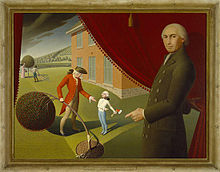Biography Day
Listen to the Recess! Clip
| Author | Rita Smith |
| Air Date | 5/16/2000 |

Biography Day Transcript
In celebration of Biography Day, I am going to read from one of the first biographies of George Washington for young people, written by Mason L. Weems, first published in 1800. In this biography, Weems focused on the private rather than the public life of Washington, because not every child can be president or lead his country to victory against the British, but “every child can become a George Washington in piety and patriotism, in industry and honor, in self esteem, universal respect,” and honesty. “It is he private virtues,”(1) Weem’s writes, “that lay the foundation of all human excellence …[so it should] be our first care to present these in all their lustre before the admiring eyes of our children.”(2)
Several more editions followed in the next five years and then in 1806 Weems wrote an enlarged and “greatly improved” edition. One of the improvements was the inclusion of the now very famous cherry tree story. Weems claims the story was told to him twenty years earlier by “an ancient lady who was a distant relation,”(3) but in fact, it was wholly invented, and entered the folklore of the young nation, profoundly influencing the American idea of Washington. Here is Weems’ story:
“When George was about six, he was made the wealthy master of a hatchet! of which he was immoderately fond, and was constantly going about chopping every thing that came in his way. One day, in the garden, he tried the edge of his hatchet on the body of a beautiful young English cherry tree.The next morning [his father], [found] out what had befallen his tree.No body could tell him anything about it. Presently George and his hatchet made their appearance. George, said his father, do you know who killed that beautiful little cherry tree yonder in the garden? This was a tough question, and George staggered under it for a moment; but quickly recovered himself; and looking at his father, with the sweet face of youth, brightened with the inexpressible charm of all triumphant truth, he bravely cried out, “I can’t tell a lie, Pa, you know I can’t tell a lie. I did cut it with my little hatchet.”(4)
So there is it, an invented story which illustrates for children a truth about Washington’s exemplary character: He was an honest person. One critic, Robert Miner Jr., has pointed out that in this biography Weems’ inventions are not so much a “mis-handling of the facts of Washington’s early life as a myth-handling, a journey,” he says, “beyond mere history to the collective unconscious of the nation.”(5)
Notes
(1) The Life of Washington the Great, by Mason L. Weems. Agusta: George F. Randolph; reprinted in facsimile by Garland Publishing, Inc., 1977. p. 5
(2) Ibid.
(3) Ibid., p. 7
(4) Ibid., p. 9
(5) Ibid., p. ix
Sources
Weems, Mason L., The Life of Washington the Great, Augusta: George F.Radolph, 1806; reprinted in facsimile by Garland Publishing Inc., New York, 1977, with a Preface for the Garland edition by Robert G. Miner, Jr.